Update #2: Wednesday, March 3, 10:02EST
TAKEAWAY: We present prototype pages for dramatic changes in the Daily News, plus new variations of page one for The Philadelphia Inquirer, and branding ideas for philly.com. Suddenly, our Philadelphia story project moves from the philosophical to the specific. PLUS: Chile earthquake follow up: one eyewitness account continues AND: At US Airways: a terrible case of the nastys.
Our Philadelphia story continues.

A table full of prototype pages, tons of ideas, a day of looking at the way things could be
On this, our third visit to Philadelphia, Reed Reibstein and I arrived early, were ushered into the 12th floor where the big executive conference room is, and got to see the top resident canine on that floor, a black poodle named Franklin (perhaps named after that other famous Philadelphian and sometimes journalist, Benjamin Franklin? ), who was a bit camera shy at first, but then decided to please.
This week it was our turn to present pages of what we would do with the Daily News, the tabloid, highly local newspaper that is as much a staple of Philadelphia life as the famous Philadelphia Cheese steak.
Of course, we also had some front pages of The Inquirer, and additional work on branding issues related to philly.com, the newspapers’ website.
For the Daily News: big relaunch?
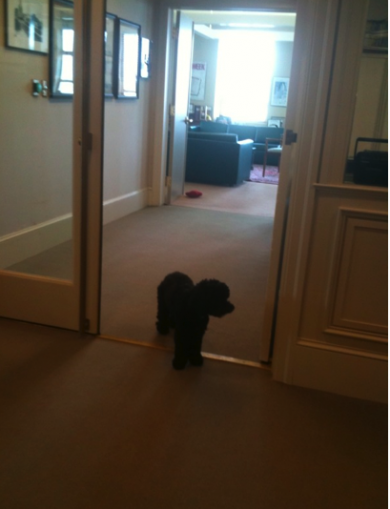
Meet Franklin, The Philadelphia Newspapers’ resident canine: life is full of sweet bones in the executive suite
One of the top questions here is the degree to which the Daily News will change.
Will this be an evolutionary, step-by-step introduction of new concepts, new typographic fonts, a more modern navigation, and a completely different approach to Page One?
Will the logo change? (We have presented options in case it should, which we tend to favor)
Or, will the changes be subtler, retaining the existing pillbox red logo, the same typographic fonts, and the same spirit?
We have now presented what we would do; so internal discussions must follow in the days ahead.
In any case, one of the foundations of our work with the Philadelphia newspapers is to better integrate the print/online editions, and our prototypes go the distance to present how we would suggest they do that.
It is great to see that the editors like what they see, and that our prototypes remind them of how things could be in the area of integration of print/online.
One year in bankruptcy
The Philadelphia newspapers have just marked their first year in bankruptcy court. Not a date to celebrate, specifically, but one to note as we continue to tell the Philadelphia story, and the reason why we at Garcia Media have volunteered to join the talented and energetic team here, led by Brian Tierney, and to offer what we consider to be ideas that may help the newspaper gain new readers, become more print/online friendly, and, of course, emerge from its financial woes.
On that account, I am happy to hear that there are several suitors interested in the newspapers, and that perhaps an auction will be held in the near future.
Both the Inquirer and the Daily News seem to have good advertising numbers today, and we have already seen progress in the integration of print/online, although not all that we would like to see.
Our work continues and both Reed and I are happy to see—-at the end of this visit—-that we have graduated from philosophical discussions of what could be, to specific examples of how it is when the ideas land on a page.
Our discussions today ended with the prospect of the iPad editions, looking at the rest of 2010 and beyond.
There is a future for the Philadelphia newspapers, and if you sat with the editors, as we have, you would realize that it is likely to be a promising future.
Something that we are sure that investors and possible future suitors of the Philadelphia newspapers would like to hear more about.
Previous blogs about The Philadelphia Story
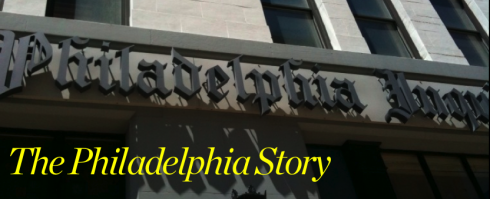
A very special project for me: The Philadelphia Story
https://garciamedia.com/blog/articles/a_very_special_project_for_me_the_philadelphia_story
The Philadelphia Story: Discussing the Non-Project Project
https://www.garciamedia.com/blog/articles/the_philadelphia_story_entry_2_discussing_the_non_project_project
The Philadelphia Story (Entries 3-4-5):I recognize this conference roomhttps://www.garciamedia.com/blog/articles/the_philadelphia_story_entry_3_i_recognize_this_conference_room
The Philadelphia Story (Entry #6): We present; positive reactions
https://www.garciamedia.com/blog/articles/the_philadelphia_story_entry_6_we_present_positive_reactions/
In Philadelphia: moving philly.com to the top of the page
https://www.garciamedia.com/blog/articles/in_philadelphia_moving_philly.com_to_the_top_of_the_page/
US Airways: the flight of the nasty
Some days are not good for flying.
Some days are not good for airline personnel.
Some days “nasty” prevails.
Tuesday was probably one of those days. Or perhaps it is always like this with US Airways?
I was scheduled to fly US Airways from Philadelphia to Tampa, and it was a case of the “nastys” at all three steps for me along the way.
I called the 800 reservations number Monday night to reconfirm my flight and to inquire about possibility of upgrades. The woman who answered was cut and dry, not at all friendly, less at all helpful, and the tone made me feel like I was an incompetent someone intruding on her time. I said thank you and hung up, not feeling very wanted by US Airways, in spite of my Platinum Preferred status with the airline.
Then Tuesday, I got to the airport early, and tried to check in using one of the self service stations, but the computer would simply not take my card, or acknowledge me (I refuse to think that the computer was playing nasty to go along with the rest). I approached a man behind the counter, who proceeded to lecture me on everything I was doing wrong, as if I was a five year old unable to go to the bathroom by myself in a kindergarten class. Nasty.
With my boarding pass in hand, I proceeded to the US Airways Club. The lady at the front desk asked me for my membership card, I showed my Lufthansa HON Circle card (the highest you can go with the German carrier, and Star Alliance member, like US Airways). Apparently, she had not seen one of those cards, so she said: Sir, you have to be Gold.
“Well, HON Circle is higher than gold,” I said, and I wonder how the George Clooney character in the high flying flick Up in the Air would have reacted, except that he flew American Airlines and it probably would not have happened there.
“Oh, OK,” she said matter of fact, and ushered me in. Another nasty moment.
Finally, I boarded Flight 735 to Tampa. Not a good experience for a Platinum Preferred customer of US Airways.
I wonder what the degree of nasty is for the NON-preferred customers. Better yet, I don’t want to know.
Tip for those doing training of personnel at US Airways: Teach them to speak softly, leave the stick at home and respect their customer’s intelligence. Even when we the customers don’t know better, it is nice when you make us feel as if we do.
Chile earthquake: follow up
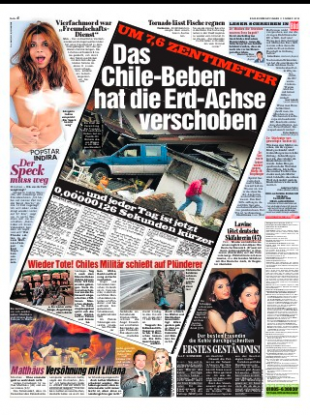
Today’s Bild Zeitung, of Germany, shakes it on the page as it covers the continued story of the Chilean earthquake
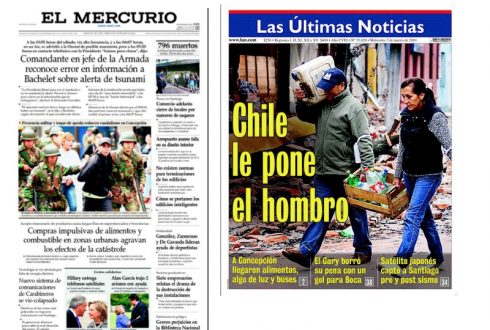
Today’s El Mercurio and Ultimas Noticias, Santiago de Chile
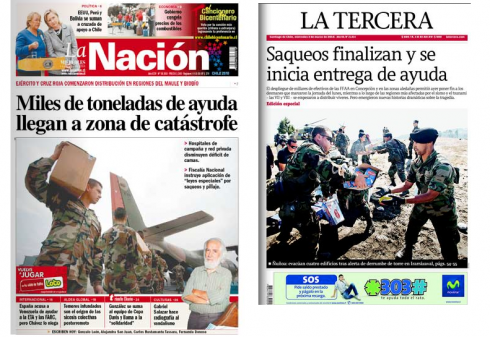
Today’s La Nacion and La Tercera, Santiago de Chile
Javier Devilat, a Chilean designer and my former student at Poynter, continues to update me on the situation in his country following the 8.8 scale earthquake that caused major destruction and over 700 deaths.
In a moving email, Javier offers us a glimpse of his thoughts four days after the earthquake:
For some reason, it is always the same group that suffers, Mario: the poorest of them all. They are the ones who constantly have to be trying to get up, and, amazingly, they always do. They spend their lives getting up and moving on.
On the other hand is my group. I belong to the group of the “favored ones”, the ones unrtouched by the tragedy, the ones who have a job, food, shelter, education. In our case, once we get up, reach a position, we can enjoy it, we continue to build upon it.
Mario, all that I lost in this tragedy was an already opened bottle of vinegar.
And, although nothing happened to me and my family, one finds it difficult continuing life business as usual. Yes, we have donated food and clothing and material things, but nothing compensates for this difference between the ones who have and the ones who don’t. After the dead are counting, after the headlines with the big numbers, what remains is the survivors and their loss. The families who won’t be able to send their kids to school, or the many young college students who must drop out now to help their families, their dreams of success shattered by this tragedy, not to mention the thousands left jobless.
It is also extremely disheartening to see people looting the stores. I am not talking about the mothers who steal milk to feed their children. No, I am talking about those who go into a store to steal TV sets, computers, cameras. Yesterday, in our country, it was nature versus man, but today it is man against man. This finds me sort of depressed and not feeling good at all.
But, we must continue to work, to do our best to make sure that this country can get up and keep moving again.
The role of the press in Chile after earthquake
Javier Devilat sends us daily analysis of how the press is handling the story of this tragedy. He is right when he writes me that, it is during moments like this, following a tragedy of such magnitude, that people turn to their newspapers for information, for service, to get a sense of guidance of how to survive. Some newspapers rise to the occasion in such moments, others don’t.
Javier points out that an interesting observation is the role of advertising in the newspapers.
All the newspapers are packed with ads, mostly companies showing their support of the people and the country, in addition to ads that specifically report the troubles they are having restoring regular services to their customers.
Offering iPad services
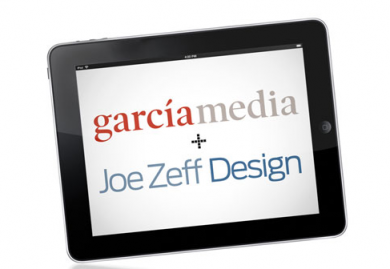
As you could see when you first entered our Garcia Media site today, we now are very happy and proud to offer our services to any organization contemplating entering the iPad world for editions of their newspapers, magazines, books, etc. As we are already engaged with clients that are going to be among the first to have an iPad edition, we are aware of the planning that goes into entering the iPad, and we have joined forces with Joe Zeff, of Joe Zeff Design, to form a unique and unparalleled team that is there to help you.
This is new territory for everyone, and the scope of iPad projects cannot compare to that which we are accustomed to, as in the case of a redesign of a newspaper or magazine. Therefore, we feel that we have to offer a variety of programs to those interested in contemplating their iPad future.
As such, one of our programs will be My iPad Baby Steps® , where we guide an organization early on, as it starts thinking of the iPad, but has no concrete plans yet on how to get there.
Of course, then we have the full program offering.
To us, going iPad means planning strategies in five different areas: business strategy (how to monetize it), editorial (storytelling possibilities), user experience strategy (how your audience engages with your brand), technical (how it works), advertising (creating meaningful partnerships with advertisers, exploring new and creative opportunities for advertising). These are the five centerpieces of any iPad project. We at Garcia Media are prepared to assist your organization take steps that will guarantee a smooth iPad launch when you are ready.
Let us hear from you and your plans.
Everyone needs a mentor
This is part 4 of my occasional series 40 Years/40 Lessons, which I call a “sort of career memoir” capturing highlights and reminiscing about what has been a spectacular journey for me, doing what I love most. Today’s segment: Mentors play a key role to help us make it to the finish line
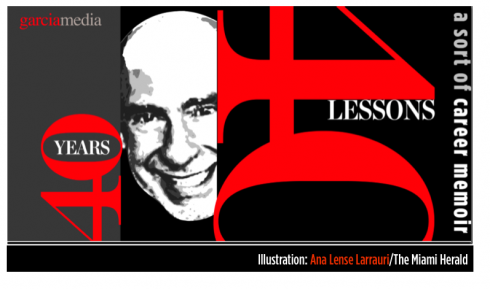

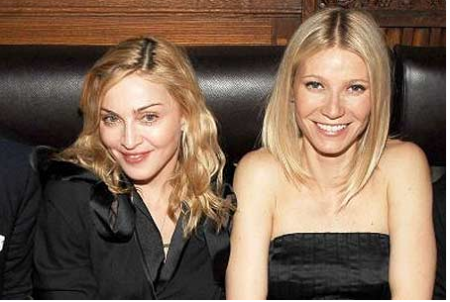
Madonna is mentor to Oscar winning actress Gwyneth Paltrow
I had the best mentors and, perhaps, as a result, I also have had the best mentorees.
I was lucky to encounter mentors in the BPC era. Yes, Before Personal Coaches.
One can now recruit a personal coach, interview several potential candidates then pick the one we wish to assist us to do a job more effectively and/or to progress in our careers.
Personal coaches are now part of the fabric of networking, advancing and beating the competition. In my growing up years, we had no personal coaches as such. Instead, we had mentors.
A mentor would appear without the prerequisite interview.
They were not hired.
There was no transaction, except for that one day when you just knew you had met your mentor. It is hard to tell how you knew you were in the presence of your mentor one fateful day, but you just knew it.
I have to admit that the process was rather informal, highly personal and not as military sounding as it seems to be today, when personal coaches begin by plotting “strategy and tactics” to build up someone’s career.
Mentoring one semester at a time
Maybe we called it differently, although the goals were similar: the mentor would discover you, would then decide that you were worth cultivating to take you as high as your potential—-and your own goals—-could advance you.
As part of “strategy” the good old mentors would hold regular meetings with you, review what progress you had made, and ask about your immediate goals for the next few days or months. The mentors I knew dealt with “semesters”, which seemed more realistic than ” a lifetime.” But all those semesters of mentoring added to lifetime of realizations.
No matter how formal or informal the mentoring process is, everyone needs a mentor.
The first Mentor
The original Mentor is a character in Homer’s epic poem The Odyssey. When Odysseus, King of Ithaca, went to fight in the Trojan War, he entrusted the care of his kingdom to Mentor. Mentor served as the teacher and overseer of Odysseuss’ son, Telemachus.
The Merriam-Webster Dictionary defines a mentor as “a trusted counselor or guide.” For their Mentor/Protégé Program, the Anesthesiology Department of Cleveland’s MetroHealth System defines mentor as “a wise, loyal advisor or coach.”
Wise and loyal. Those are the two key words that best define the mentors I was lucky to have. I refuse to use the word coach to describe any of them.
My first mentor
Her name was Miss Ann Congelo, and she taught English at Miami High. It was my junior year and we were studying American literature, for which I felt passionate from day one. One author after the other opened different avenues and presented me with a variety of different English words, Americanisms and sentence structures that combined to teach me the language, as well as the culture of my new country.
Enter Miss Congelo, who died young.
She was the definition of teacher (aren’t all mentors?). Loved her subject matter, knew it like an expert, and did not count the hours she spent in the classroom, which is why, when I told her that I was interested in reading additional books to the ones assigned in our class list, she looked at me with her big green eyes, smiled, and offered to create a book list for me.
We decided to meet twice a week so I could offer “book reports” and tell her about my readings. Miss Congelo would read Emily Dickinson’s melancholic poetry, stopping to tell me what some of the words meant.
Miss Congelos’ favorite Dickinson poem was “if you were coming in the fall”. When she read it to me, we were the only two people in the room, sitting by her desk, next to those big Miami High School windows, the tall palm trees swaying just outside. I was only 15, but I could tell that Miss Congelo had memorized the words in the poem, and would close her eyes, look away from me, and feel each word of the poem.
No better way to learn English. Without knowing it, I had discovered my first mentor. To this day, every time I use the word “nimble” I remember Miss Congelo, who taught it to me.
I always wondered if Miss Congelo, like Emily Dickinson, had failed to realize her romantic fantasies. I have often thought about it as I re read this poem.
If you were coming in the fall,
I’d brush the summer by
With half a smile and half a spum,
As housewives do a fly.
If I could see you in a year,
I’d wind the months in balls,
And put them each in separate drawers,
Until their time befalls.
If only centuries delayed,
I’d count them on my hand,
Subtracting till my fingers dropped
Into Van Diemen’s land.
If certain, when this life was out,
That yours and mine should be,
I’d toss it yonder like a rind,
And taste eternity.
But now, all ignorant of the length
Of time’s uncertain wing,
It goads me, like the goblin bee,
That will not state its sting.
Of course, Miss Congelo would ask me me to underline words I did not understand. In this poem, a dozen: spum, befalls, Van Dieman’s land,yonder, rind, goads, goblin bee. Miss Congelo will patiently tell me what each word meant, then she would pronounce it slowly, looking at me, making me look at her lips.
First class mentoring from a teacher who died too young. I am happy she was in my life.
Enter Miss G
At Miami-Dade College, I first met my next mentor, Barbara Garfunkel, one hot day in July. It was the summer break but I could not wait to get into the staff of the student newspaper, Falcon Times, and the first step was to meet the advisor. I knew, at the end of that meeting that July 17, 1965 would be a day I would remember. Indeed, at home we had one of those old calendars in our kitchen where you would rip each page off at the end of the day. That night, I saved July 17 in my diary. I knew I had met someone who would make a difference.
Petite, green eyed, and always impeccably dressed in print dresses, and matching custom jewelry, Barbara Garfunkel was the grand dame of journalism education in Miami. Anyone you met at The Miami Herald or The Miami News had been a student of Miss G. She had mentored many, and was proud of it. You mentioned Miss G in the newsrooms around Miami and people smiled, and then proceeded to recount a Miss G anecdote.
Mentors teach.
Mentors mold.
Mentors see in you what you still don’t see in yourself.
They possess special lenses, perhaps, or an antenna that picks up vibes in that person sitting across from them. Whatever it was, Miss G spent two hours with me that first day I met her, explained all about the newspaper, and welcomed me in it. The rest was hard work and discipline, which, by the way, is always the case.
Mentors guide you, mentors don’t give you discipline or do the work for you.
The best mentors demand without making it sound like an order. You simply do not wish to disappoint the mentor, so you try harder. There is nothing wrong with working extra hard not to disappoint, especially if the person you don’t wish to disappoint is yourself.
For Miss G, perfection was the key. I would write my weekly column for the Falcon Times, and she would sit there with me, pushing me to explain a point I had made better, or questioning an assumption not based on facts. I learned tons from Miss G; to this day, I often feel her presence near me when I am writing and see her, pencil in hand, deleting, adding, enhancing the copy.
Then along comes Dr. Sanderson
At the University of South Florida, my mentor quickly became Professor Arthur (Sandy) Sanderson, a Minnesotan who had made Florida home. A short man with a little white hair, he also had a sort of blondish moustache, the result of his constant smoking. In those days, if the professor smoked, he did it in his office.
With Dr. Sanderson, it was first class mentoring, and second hand smoke.
First class mentoring it was. Dr. Sanderson took me under his wing as I became editor of the University’s daily, The Oracle, and he ran the newsroom like it was The New York Times. You had to follow style, meet deadlines, and rewrite, rewrite and rewrite, till all facts were checked three times.
The University of South Florida in 1968 was exploring a medical school (it now has it, and it is nationally recognized), so I was doing weekly stories on the planning stages for the school. I would think I would have it all, return to the newsroom, then Dr. Sanderson,a cigarette forever dangling from the side of his mouth, blue eyes moving from side to side as he read, would take a pencil and cross entire lines out, put question marks here or there, then look at me with a barrage of questions about what I had left out of the story.
“Go back to these two sources, Mario,” he would say in his Midwestern accent. “There is more to the story than you project here. Push those sources. Make them tell you more.”
My defenses would drop. I would feel disarmed. But a power within me would propel me to return to the sources of my story, and to rewrite it, then sit with the patient but demanding professor again. At the end, the story was complete, and my mentor, Dr. Sanderson, would give me praise and incentive.
Mentors do that. They push you hard. They praise you accordingly. To the mentors, you are a teddy bear. Ironically, to the mentorees, the mentors ARE the teddy bears. They make you feel safe and comfortable within your own boundaries.
In Oklahoma, Jim Paschal
I had already graduated, and I was teaching, when I won a Newspaper Fund Fellowship to study at the University of Oklahoma. It was an honor for a college professor to get such a Fellowship, and 12 of us gathered there to study for three weeks, and become better teachers.
That is how I met one of my most theatrically memorable mentors: the late Prof. James F. Paschal. He would become a lifelong friend to me and my family. Jim Paschal taught journalism, but he had a passion for scholastic journalism, student newspapers and yearbooks, and he was certain that participation in student publications made a student a better citizen, regardless of whether they were interested in a journalism career. Of course, after students attended a Jim Paschal workshop, THEY forever wanted to go into journalism. Legions of his students did.
Jim played the piano like a pro, and he loved everything about Walt Disney (had held a job at Disneyland in California during his college years). To this day, when I hear the signature Disney song “When you Wish upon a Star” i immediately think of Jim Paschal and his passion for our profession, his impeccable timing in front of a class (master teacher that he was), and the fact that he was a showman, knew it and did not try to hide it.
Two weeks into the workshop at Oklahoma, Jim pulled me aside one day and said: “You were born to teach, and I think I’d like to join me on a workshop for high school and college journalists next month.”
Showman Jim and showman Mario hit the road to do workshops nationally from coast to coast that summer, and for many years after that.
My mentor Jim taught me that passion is the key and that perfection is not a choice.
I loved that man and what he meant to me, Maria and the children.
Yes, all of my mentors are now deceased. But mentors brand you. Their teachings, guidance, recommendations and, most importantly, their faith in you,, stays there, intact. When you begin to have self doubts, you can see their faces, hear their voices, believing in you. Then, somehow, you straighten yourself up, give them a nod and move on.
Then, suddenly, the constant evolution of life in all its manifestations makes YOU a mentor.
I have mentored many, and I am honored that they would give me the chance. I continue to do that, and will probably do it to the end.
Mentors believe in you and push you to pursue your dreams.
In my view, nobody makes it without that mentor and that push.
The good mentors are happy when the mentorees fly higher than they did.
It happened to Madonna when her mentoree, Gwyneth Paltrow, won the Oscar for best actress.
So, Miss Congelo, Miss G, Dr. Sanderson and Jim Paschal, there would be no 40 Years/40 Lessons without the enormous role that you played in my life.
And, Prof. Paschal, you taught me, in the great Disney tradition, that if you wish upon a star, makes no difference who you are.
I will add that the difference is the mentor you hitch your star to.


1.Mirrors.
https://www.garciamedia.com/blog/articles/40_years_40_lessons_1—a_look_in_the_mirror
2.Refugee.
https://www.garciamedia.com/blog/articles/40_years_40_lessons_2—refugee
3.Teacher..
https://www.garciamedia.com/blog/articles/40_years_40_lessons_3—teacher/
TheMarioBlog post #497